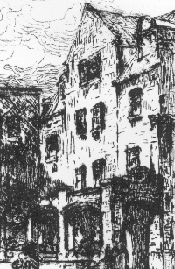Alan Trachtenberg's Incorporation of America outlines the major
economic, social, and
psychological changes that resulted from the turn of the century's
industrial revolution. The subsequent massive mechanization of society left
those in the lower echelons in its wake. A new class of vastly wealthy
people was born, replacing a society in which only a moderate disparity had existed.
Along with Gilded Age's greater socioeconomic gaps, came the advent of the corporation,
a legal entity with preferential law on its side. Incorporation became a model for
other institutions and a whole new wave of professionalization appeared.
Trachtenberg looks specifically at Chicago, a city created by corporations and
driven by financial construction. The huge underclass flooding Chicago
looking for work found a lack of low cost housing and inadequate
wages. Immigrant workers more and more became "the other," beings who needed
to be Americanized.
 The first generation of educated
upper class women in Chicago responded to this need. With societal norms
dictating few career options for these women, some found that "with all their
apparent leisure they had nothing to do" (Miller,418). Soon Hull-House was born.
Jane Addams, along with Ellen Gates Star, started a unique home with twenty
or so residents that attempted to offer not only food and shelter but also
educational and cultural sustenance to those of the lower class. Addams and Star did
not just start a settlement but contributed to (some would say invented)
the professionalization of social work. In an attempt to raise the social class of its inhabitants, Hull-House sought to Americanize immigrants.
This burgeoning field was one of few open to women, possibly
because of its traditionally female role of caring for others. Hull-House
not only sought to
mold and "bettter" immigrant workers but to study them, formulate
theories, furnish data for legislation, and publish its results. Hull-House was not another little sisters
of charity (previous occupants of Hull-House) who offered God as a solution to social ills but an experiment in progressive theory offering education as a cure-all.
Addams, the Abbott sisters, Sophonisba P. Breckinridge and her other fellow female
cohorts worked closely with educational leader John Dewey and University
of Chicago professors. Hull-House made a lasting impression on the field
of social science, was a voice for those less fortunate and opened the gateway
for women in the professional arena. Hull-House is not without its critics. Some call it a corrupt corporation that under the guise of social reform incorporated or assimilated immigrants into a manner of life deemed acceptable to Ms. Addams and those of her class. The first generation of educated
upper class women in Chicago responded to this need. With societal norms
dictating few career options for these women, some found that "with all their
apparent leisure they had nothing to do" (Miller,418). Soon Hull-House was born.
Jane Addams, along with Ellen Gates Star, started a unique home with twenty
or so residents that attempted to offer not only food and shelter but also
educational and cultural sustenance to those of the lower class. Addams and Star did
not just start a settlement but contributed to (some would say invented)
the professionalization of social work. In an attempt to raise the social class of its inhabitants, Hull-House sought to Americanize immigrants.
This burgeoning field was one of few open to women, possibly
because of its traditionally female role of caring for others. Hull-House
not only sought to
mold and "bettter" immigrant workers but to study them, formulate
theories, furnish data for legislation, and publish its results. Hull-House was not another little sisters
of charity (previous occupants of Hull-House) who offered God as a solution to social ills but an experiment in progressive theory offering education as a cure-all.
Addams, the Abbott sisters, Sophonisba P. Breckinridge and her other fellow female
cohorts worked closely with educational leader John Dewey and University
of Chicago professors. Hull-House made a lasting impression on the field
of social science, was a voice for those less fortunate and opened the gateway
for women in the professional arena. Hull-House is not without its critics. Some call it a corrupt corporation that under the guise of social reform incorporated or assimilated immigrants into a manner of life deemed acceptable to Ms. Addams and those of her class.
|


 The first generation of educated
upper class women in Chicago responded to this need. With societal norms
dictating few career options for these women, some found that "with all their
apparent leisure they had nothing to do" (Miller,418). Soon Hull-House was born.
Jane Addams, along with Ellen Gates Star, started a unique home with twenty
or so residents that attempted to offer not only food and shelter but also
educational and cultural sustenance to those of the lower class. Addams and Star did
not just start a settlement but contributed to (some would say invented)
the professionalization of social work. In an attempt to raise the social class of its inhabitants, Hull-House sought to Americanize immigrants.
This burgeoning field was one of few open to women, possibly
because of its traditionally female role of caring for others. Hull-House
not only sought to
mold and "bettter" immigrant workers but to study them, formulate
theories, furnish data for legislation, and publish its results. Hull-House was not another little sisters
of charity (previous occupants of Hull-House) who offered God as a solution to social ills but an experiment in progressive theory offering education as a cure-all.
Addams, the Abbott sisters, Sophonisba P. Breckinridge and her other fellow female
cohorts worked closely with educational leader John Dewey and University
of Chicago professors. Hull-House made a lasting impression on the field
of social science, was a voice for those less fortunate and opened the gateway
for women in the professional arena. Hull-House is not without its critics. Some call it a corrupt corporation that under the guise of social reform incorporated or assimilated immigrants into a manner of life deemed acceptable to Ms. Addams and those of her class.
The first generation of educated
upper class women in Chicago responded to this need. With societal norms
dictating few career options for these women, some found that "with all their
apparent leisure they had nothing to do" (Miller,418). Soon Hull-House was born.
Jane Addams, along with Ellen Gates Star, started a unique home with twenty
or so residents that attempted to offer not only food and shelter but also
educational and cultural sustenance to those of the lower class. Addams and Star did
not just start a settlement but contributed to (some would say invented)
the professionalization of social work. In an attempt to raise the social class of its inhabitants, Hull-House sought to Americanize immigrants.
This burgeoning field was one of few open to women, possibly
because of its traditionally female role of caring for others. Hull-House
not only sought to
mold and "bettter" immigrant workers but to study them, formulate
theories, furnish data for legislation, and publish its results. Hull-House was not another little sisters
of charity (previous occupants of Hull-House) who offered God as a solution to social ills but an experiment in progressive theory offering education as a cure-all.
Addams, the Abbott sisters, Sophonisba P. Breckinridge and her other fellow female
cohorts worked closely with educational leader John Dewey and University
of Chicago professors. Hull-House made a lasting impression on the field
of social science, was a voice for those less fortunate and opened the gateway
for women in the professional arena. Hull-House is not without its critics. Some call it a corrupt corporation that under the guise of social reform incorporated or assimilated immigrants into a manner of life deemed acceptable to Ms. Addams and those of her class.